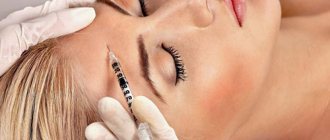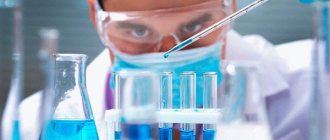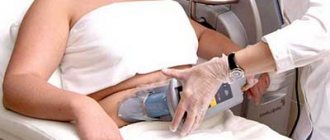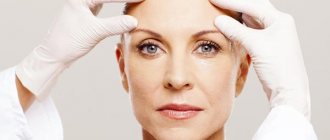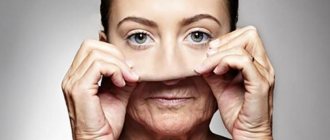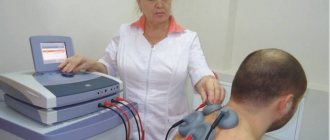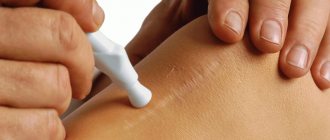Compatibility of antibiotics and hyaluronic acid
If we consider the pharmacological side of the issue, then there are no contraindications. The compatibility of the drugs is good, they do not touch or interact with each other. But why do many cosmetologists not recommend doing biorevitalization while taking antibiotics? This indicator is strictly individual; one must proceed from the patient’s condition.
Side effects of taking antibiotics that affect the effectiveness of biorevitalization:
- Disturbance of the balance of normal microflora;
- Reduced intestinal protective barrier;
- Decreased immunity;
- Increasing the body's sensitivity to allergens.
Because of this, the simultaneous use of these agents is not recommended. Even taking into account the allogenic nature of hyaluronic acid, its hypoallergenicity, it can cause unpleasant reactions. The reason for this is the foreignness of the composition.
Care and what not to do after the procedure
The rehabilitation period usually lasts no more than 3-4 days. To alleviate the condition, the doctor will recommend special products and masks.
For quick healing you need to follow the recommendations:
- You should not lubricate your lips with cosmetics on the first day;
- you should avoid hot drinks, drink alcohol and smoke;
- you need to postpone visiting the bathhouse and the beach.
If the discomfort does not go away, then you should visit a cosmetologist to prevent unpleasant consequences.
When can biorevitalization be performed after antibiotic therapy?
It would seem that after taking antibiotics, no bacteria threaten the beauty of the face after injection procedures. But it is not so. A decrease in the protective barrier and disruption of normal microflora is the cause of the development of pathogenic bacteria. A striking example of this process is thrush after massive antibiotic therapy. Many people note the development of candidiasis as a side effect of antibacterial drugs. A similar process occurs with the skin.
Slight dryness or increased fat content, a decrease in turgor and elasticity may not be noticed, especially during the treatment of infectious diseases. But even minimal changes can lead to disastrous consequences. Therefore, biorevitalization should not be carried out while taking antibiotics.
The reason for taking antibiotics is also a concern. Past illnesses are a huge stress for the body. An increase in temperature, inflammatory processes, and a decrease in the body's resistance to environmental factors always accompany illness. It is not recommended to use any injection procedures until complete recovery.
It is impossible to determine the standard period that must be maintained before biorevitalization, after antibacterial therapy. You always need to follow individual indicators - the presence of side effects after medications, weakness, pain, abnormal changes.
The use of antibacterial agents may be required after the procedure. These can be independent diseases, or side effects after biorevitalization. In this case, the use of antibiotics is justified, especially considering the fact that the rehabilitation period after the procedure is short. And the body did not experience severe stress due to infectious diseases.
You should not use antibiotics on your own after biorevitalization, because it is dangerous. In addition, their use must be justified. High fever, the appearance of acne and swelling are not always reasons for drug treatment. Sometimes it is worth resorting to taking gentle anti-inflammatory drugs, the number of side effects of which is minimal.
Source: Aesthetic Medicine Clinic “FACES”
Published 02/14/2020 · | Category: Beauty and health
Symptoms
The first reason is increased sensitivity of the body
For the sake of beauty and “eternal” youth, women are ready to take risks. No one is immune from allergies, but you should be careful when handling various substances. Characteristic features of an allergy to hyaluronic acid are:
- severe itching and burning at the site of contact with the substance;
- hyperemia;
- swelling;
- change of color in the treated area;
- manifestations of urticaria.
In addition to the severe symptoms of an allergic reaction, some other types of complications may occur, namely:
- hematomas;
- necrosis at the injection site;
- appearance of subcutaneous nodes.
Biorevitalization and antibiotics. Are they compatible?
- Cosmetology
- Body correction
- Plastic surgery
- Treatment and correction of skin imperfections
- Face and body problems
- Services
- Prices
- Addresses
- Doctors
- Reviews
- Photos of works
- Stock
- Gift certificates
- Cosmetology
- Contour plastic
- Lifting with mesothreads
- Biorevitalization
- Facial mesotherapy
- Peelings
- Photorejuvenation
- Face cleaning
- Laser hair removal
- Fractional photothermolysis
- Thermolifting
- RF face lift
- Bioreinforcement
- Bioreparation
- Bioremodeling
- Hand skin rejuvenation
- Placental therapy
- Laser rejuvenation
- HIFU SMAS lifting
- Treatment of pigmentation
- Hardware care Skin Master
- Laser facial resurfacing
- Biorestructuring
- Facial rejuvenation
- Revitalization
- Botulax
- PRP therapy (plasma therapy)
- Thermage
- Body correction
- Pressotherapy
- Body mesotherapy
- Ozone therapy
- Massage for weight loss
- Wraps
- Cryolipolysis
- Ultrasonic liposuction
- Laser lipolysis
- Carboxytherapy
- Cavitation AMI
- R-Sleek procedure
- RF body lifting
- Myostimulation
- Plastic surgery
- Blepharoplasty
- Liposuction
- Lipomodeling
- Otoplasty
- Hair transplantation
- Chin surgery
- Circular facelift
- Rhinoplasty
- Intimate plastic surgery
- Endoscopic lifting
- Neck lift
- Abdominoplasty
- Scar surgery
- Lipofilling
- Mammoplasty
- Gynecomastia
- Treatment and correction of skin imperfections
- Stretch Mark Removal
- Treatment of rosacea
- Resurfacing of scars
- Getting rid of cellulite
- Acne treatment
- Rosacea treatment
- Correction of the tear trough
- Correction of facial oval
- Double chin removal
- Remove bags under eyes
- Remove nasolabial folds
- Spinal diseases
- Pinched nerve
- Dorsopathy
- Myositis
- Protrusion
- Radiculopathy
- Contour plastic
- Lip augmentation
- Juvederm
- Restylane Perlane
- Surgiderm
- Contour plastic surgery of nasolabial folds
- Yvoire
- Restylane
- AestheFill
- Biorevitalization
- Non-injection biorevitalization
- Teosyal
- JaluPro
- Repleri
- IAL-system
- Restylane Vital
- Viscoderm
- Biorevitalization SKIN
- Genyal
- Collost
- Biorevitalization Novacutan
- Peelings
- Jessner Peel
- Facial peeling
- Chemical peeling
- Glycolic peeling
- TCA peeling
- Gas-liquid peeling
- Peeling with fruit acids
- Yellow peeling
- Peeling PRX–T33
- Peeling Cimel
- Face cleaning
- Ultrasonic cleaning
- Atraumatic cleaning
- Laser hair removal
- Laser hair removal for bikini
- Laser lip hair removal
- Laser hair removal for men
- Laser hair removal for armpits
- Laser facial hair removal
- Hair removal with diode laser
- Thermolifting
- Fractional thermolifting
- Bioreparation
- Meso-Wharton
- Hyalrepair
- Mesoeye
- MesoSculpt
- Meso-Xanthin
- Laser rejuvenation
- Laser rejuvenation Fotona
- Laser rejuvenation Palomar
- Laser facial resurfacing
- CO2 laser resurfacing
- Massage for weight loss
- Anticellulite massage
- Lymphatic drainage massage
- Vacuum massage
- Modeling massage
- Wraps
- Algae wrap
- Bandage wrap
- Blepharoplasty
- Transconjunctival blepharoplasty
- Removal of eyelid hernia
- Circular blepharoplasty
- Liposuction
- Leg liposuction
- Calf liposuction
- Abdominal liposuction
- Chin liposuction
- Hand liposuction
- Liposuction of the knees
- Liposuction of the pubic area
- Body liposuction
- Liposuction for men
- Facial liposuction
- Liposuction of thighs
- Non-surgical liposuction
- Hair transplantation
- Hair transplant for women
- Hair transplant for men
- Beard
- Rhinoplasty
- Rhinoseptoplasty
- Laser rhinoplasty
- Intimate plastic surgery
- Labia reduction
- Abdominoplasty
- Tummy tuck after childbirth
- Lipofilling
- Lipofilling of the mammary glands
- Mammoplasty
- Breast lift (mastopexy)
- Reduction mammoplasty
- Breast augmentation
- Pinched nerve
- Pinched cervical nerve
- Pinched thoracic nerve
- Brachial nerve entrapment
- Pinched nerve in the lower back
- Pinched sciatic nerve
- Dorsopathy
- Cervical dorsopathy
- Thoracic dorsopathy
- Lumbar dorsopathy
- Myositis
- Myositis of the neck
- Back myositis
- Lumbar myositis
- Leg myositis
- Thoracic myositis
- Hand myositis
- Protrusion
- Cervical protrusion
- Protrusion of the thoracic region
- Lumbar protrusion
- Radiculopathy
- Lumbar radiculopathy
- Cervical radiculopathy
Biorevitalization is a skin rejuvenation procedure that involves the introduction of hyaluronic acid.
If we consider antibiotics, then these are also synthetic drugs that are used to destroy or suppress the activity of pathogenic bacteria. In principle, biorevitalization against the background of systematic use of antibacterial drugs is not contraindicated - the administered substances do not come into contact or interact at all.
But doctors highlight several important points that need to be taken into account when choosing the timing of injections with cocktails based on hyaluronic acid:
- Antibacterial drugs for treatment are selected by the doctor. They have an anti-inflammatory effect, and the rules for safe biorevitalization indicate that any pathological process is a contraindication to the anti-aging procedure.
- Antibiotics - a term created on the basis of the word "anti" - is translated as "against", so it can be argued that such drugs kill absolutely all living microorganisms. Biorevitalization, on the contrary, means revitalization of the body, its rejuvenation.
And if antibacterial therapy was carried out for a long time, and at the same time a cosmetic procedure was carried out, then the results may either be completely absent or be completely different from what the client expects. In this case, we are talking about rejection of the introduced cocktails.
Side effects of antibiotics
- The goals of the procedures are completely different - antibiotic treatment is necessary for health, injections with hyaluronic acid are for beauty. You will have to choose what is needed first. It is impossible to solve two problems at the same time; one of them will remain in any case.
- Each of the drugs individually can cause an allergic reaction. If they enter the body at the same time, then this probability increases significantly. Yes, cocktails for biorevitalization are positioned as hypoallergenic, but they contain not only safe hyaluronic acid, but also vitamins, plant extracts, and minerals.
After both procedures, the body needs some time to restore normal functioning. Rehabilitation after a course of antibacterial therapy involves:
- restoration of intestinal microflora;
- gradual introduction of familiar foods to the menu;
- strengthening the immune system by taking vitamin and mineral complexes.
The recovery period after biorevitalization implies some restrictions - for example, any thermal procedures, physical education, and massages are prohibited. It turns out that in the case of any of the procedures, the body’s immune system suffers, and if they are carried out simultaneously, the blow may be too powerful.
Doctors categorically do not recommend performing biorevitalization simultaneously with taking antibacterial drugs. It is much more reasonable to wait until the end of the main therapy, wait for the recovery period and only after that visit a cosmetologist about skin rejuvenation.
An increase in body temperature after injections of a drug based on hyaluronic acid is considered a rare complication, but can occur. If the indicators are not critical and decrease already at the end of the first day after the procedure, then there is nothing to worry about - most likely, this is an inadequate reaction of the body to the administered drug (it is perceived as a foreign body).
If a high temperature persists for 2 days or more, you should seek help from a doctor - this is a sign of the development of an inflammatory process.
Inflammation at injection sites can begin for two reasons:
- the infection was introduced directly during the injection - we are talking about a violation of antiseptic rules by a specialist;
- pathogenic bacteria settled in the skin during the rehabilitation period - the client did not carry out recovery measures and care correctly.
The inflammatory process is accompanied not only by an increase in body temperature, but also by pronounced redness of the skin in pathological foci, swelling, and the formation of pimples with purulent contents. This condition poses a certain threat to health and cannot be avoided without qualified medical care.
Hematomas and facial swelling after biorevitalization
Perhaps the doctor will prescribe a course of antibacterial therapy to stop the pathological process, but in this case the patient will be warned that there may be no effect from biorevitalization.
Read more in our article about biorevitalization and antibiotics.
Contraindications
Contraindications for different types of preparations with hyaluronic acid are somewhat different. Although there are categorical ones, in which the use of this substance is prohibited in any form. But even if they are completely absent, it is necessary to do a test for individual tolerance in order to avoid unpleasant surprises.
Categorical
The use of drugs with hyaluronic acid is strictly contraindicated for people with autoimmune diseases. Those who have blood relatives with similar ailments should also treat them with caution. Acting as a powerful biostimulator, hyaluronic acid can provoke their initiation or exacerbation.
You should be concerned and consult a doctor if, after injections of hyaluronic acid, three or more of the following symptoms appear at once:
- chronic fatigue;
- insomnia and depression;
- rash and itching on the skin;
- intestinal disorders;
- sudden change in weight;
- blood pressure surges;
- joint pain;
- blurred vision;
- nausea and vomiting.
In this case, you should definitely consult a doctor. Inpatient treatment may be required.
Many doctors consider pregnancy and lactation a categorical contraindication to any form of hyaluronic acid. However, its external use is not capable of causing harm to the expectant mother and baby. The only problem is that if you are prone to swelling, it can increase significantly.
For injections
Contraindications for all types of hyaluronic acid injections are numerous. This is not surprising - during injections, part of the drug enters the bloodstream. In addition, the integrity of the skin is damaged, which significantly increases the risk of complications and side effects.
Hyaluronic acid injections are not performed if:
- exacerbation of chronic diseases of internal organs;
- any forms and stages of oncology;
- the presence of active viruses and infections in the body;
- blood clotting disorders;
- any injuries and neoplasms at injection sites;
- skin diseases and infections in the work area;
- insulin-dependent diabetes mellitus;
- inflamed and purulent acne;
- subcutaneous implants in the injection area;
- tendency to form keloid scars;
- skin hypersensitivity;
- epilepsy and serious mental disorders.
Injections are not performed earlier than a month after laser resurfacing or deep chemical peels. However, after this period, they contribute to the rapid restoration and smoothing of skin texture.
It is not advisable to give injections during menstruation, at elevated body temperature, against the background of severe stress or a weakened immune system.
For oral administration
There are also a few contraindications for taking hyaluronic acid orally. In addition to pregnancy and individual intolerance, you cannot take tablets and capsules with it:
- while taking antibiotics and anticoagulants;
- during active inflammatory processes;
- for serious kidney diseases;
- people with poor blood clotting.
If you do not follow the recommended drinking regime - at least three liters of clean still water per day - symptoms of dehydration may appear. If the kidneys are not working well or there are malfunctions in the lymphatic system, drugs with hyaluronic acid can cause severe swelling.
In cosmetics
Creams and masks containing hyaluronic acid are the least effective, but the safest. The only contraindication to them is individual intolerance. There is not even an age limit. You can use such cosmetics from the age of 20 until old age.
But there are certain nuances in its application:
- Creams and masks with hyaluronic acid should not be applied before going outside in cold and windy weather. This can cause severe irritation and redness of the skin.
- In winter, it is very important to monitor the humidity in the room. When heating devices are running, the air is often dry, and creams begin to draw water from the skin rather than from the environment.
- Apply night creams with hyaluronic acid no later than two hours before bedtime. If you apply it and immediately go to bed, there is a high probability that there will be severe swelling in the morning.
Creams are applied to thoroughly cleansed skin in a thin, even layer. They distribute well, but are quickly absorbed, especially into dry epidermis. If desired, you can add a little more cream after 3-5 minutes. Residues that are not absorbed into the skin within 10-15 minutes must be removed from the face with a napkin.
Biorevitalization and antibiotics
Biorevitalization is a skin rejuvenation procedure that involves the introduction of hyaluronic acid. In general, this substance is independently produced by the human body, but for cosmetic procedures a synthetic component is used. Its effect on the body is identical to that of its own substance:
- wrinkles disappear/smooth out;
- the surface of the skin becomes smooth;
- trophic processes in tissues improve;
- blood circulation accelerates in all layers of the dermis;
- metabolism stabilizes within normal limits (metabolism at the cellular level).
If we consider antibiotics, then these are also synthetic drugs that are used to destroy or suppress the activity of pathogenic bacteria. Such drugs are not used to treat viral pathologies, because in this case they are absolutely useless.
In principle, biorevitalization against the background of systematic use of antibacterial drugs is not contraindicated - the administered substances do not come into contact or interact at all. But doctors highlight several important points that need to be taken into account when choosing the timing of injections with cocktails containing hyaluronic acid.
We recommend reading about whether papules are dangerous after biorevitalization. From the article you will learn about the reasons for the appearance of papules after biorevitalization, how long they last and when they last normally, procedures that accelerate skin recovery after the procedure.
And more about how often to do biorevitalization.
Indications
The lip augmentation procedure with hyaluronic acid is indicated in the following cases:
- Thin lips.
- The presence of scars and cicatrices in the lip area.
- Atrophy of subcutaneous fat, which can lead to unpleasant consequences reflected on the face, in the form of sunken cheeks, wrinkles, and blurred lip contour.
Hyaluronic acid is a naturally occurring substance produced by the human body. It has the ability to attract water molecules and hold them for some time.
Hyaluronic acid is used as a means for facial skin rejuvenation and lip plumping. This happens due to the fact that the substance draws water to the desired location and fills the space with it, while moisturizing and eliminating dehydration of tissue cells.
Wrinkles on the skin are pushed out, lips are enlarged, and the skin becomes fresh and hydrated from the inside. Hyaluronic acid also helps the production of collagen and elastin, the amount of which in the body becomes less than normal over the years, which leads to skin aging.
Compatibility of treatment and procedure
At the initial appointment with a cosmetologist, the client will be asked whether he is taking antibacterial drugs and, if such therapy has been carried out recently, how much time has passed since the last medication. And this is connected with very important points:
- Antibacterial drugs for treatment are selected by the doctor. They have an anti-inflammatory effect, and the rules for safe biorevitalization indicate that any pathological process is a contraindication to the anti-aging procedure.
Antibiotics are prescribed by a doctor according to indications. Before performing biorevitalization, you must inform your doctor about the reasons for antibiotic therapy
- Antibiotics - a term created on the basis of the word "anti" - is translated as "against", so it can be argued that such drugs kill absolutely all living microorganisms. Biorevitalization, on the contrary, means revitalization of the body, its rejuvenation.
And if antibacterial therapy was carried out for a long time, and at the same time a cosmetic procedure was carried out, then the results may either be completely absent or be completely different from what the client expects. In this case, we are talking about rejection of the introduced cocktails.
- The goals of the procedures are completely different - antibiotic treatment is necessary for health, injections with hyaluronic acid are for beauty. You will have to choose what is needed first. It is impossible to solve two problems at the same time; one of them will remain in any case.
- Each of the drugs individually can cause an allergic reaction. If they enter the body at the same time, then this probability increases significantly. Yes, cocktails for biorevitalization are positioned as hypoallergenic, but they contain not only safe hyaluronic acid, but also vitamins, plant extracts, and minerals.
In addition, after both procedures the body needs some time to restore normal functioning. Rehabilitation after a course of antibacterial therapy involves:
- restoration of intestinal microflora with the help of specific medications, as well as pro/prebiotics;
- the gradual introduction of familiar food products into the menu, the removal of restrictions on spicy dishes, marinades and smoked meats;
- strengthening the immune system by taking vitamin and mineral complexes.
The recovery period after biorevitalization implies some restrictions - for example, any thermal procedures, physical education, and massages are prohibited. It turns out that in the case of any of the procedures, the body’s immune system suffers and if they are carried out simultaneously, the blow may be too powerful.
Doctors categorically do not recommend performing biorevitalization simultaneously with taking antibacterial drugs. It is much more reasonable to wait until the end of the main therapy, wait for the recovery period and only after that visit a cosmetologist about skin rejuvenation.
Diagnostics
If the injection of hyaluronic acid causes a burning sensation and redness develops, this may indicate a reaction to the injection itself. This phenomenon is considered normal. However, if painful manifestations and swelling persist for two to three days, then we can judge the development of an allergic reaction. It is impossible to eliminate the hyaluronic acid molecules present in the skin, but you should begin to stop unpleasant manifestations as early as possible.
The components that trigger the allergy must be identified immediately. This will allow you to prescribe the correct therapy. To determine the type of allergen, diagnostics are carried out not only in relation to hyaluron, but any potentially allergenic substances. They can be chemical additives and preservatives.
What to do if there is inflammation or fever after biorevitalization
An increase in body temperature after injections of a drug based on hyaluronic acid is considered a rare complication, but can occur. If the indicators are not critical and decrease already at the end of the first day after the procedure, then there is nothing to worry about - most likely this is an inadequate reaction of the body to the administered drug (it is perceived as a foreign body).
If a high temperature persists for 2 days or more, you should seek help from a doctor - most likely this is a sign of the development of an inflammatory process.
Inflammation at injection sites can begin for two reasons:
- the infection was introduced directly during the injection - we are talking about a violation of antiseptic rules by a specialist;
- pathogenic bacteria settled in the skin during the rehabilitation period - the client did not carry out recovery measures and care correctly.
The inflammatory process is accompanied not only by an increase in body temperature, but also by pronounced redness of the skin in pathological foci, swelling, and the formation of pimples with purulent contents. This condition poses a certain threat to health and cannot be avoided without qualified medical care.
Perhaps the doctor will prescribe a course of antibacterial therapy to stop the pathological process, but in this case the patient will be warned that there may be no effect from biorevitalization.
We recommend reading about proper care after mesotherapy for the face. From the article you will learn about why rehabilitation after mesotherapy is important, procedures for restoring skin at home, and features of skin care after fractional and non-injection mesotherapy.
And more about what is better for young and mature facial skin - mesotherapy or biorevitalization?
Biorevitalization is a serious procedure that requires a strong immune system from the body. If it is weakened by antibiotics, then you should not expect the declared rejuvenation effect - most likely it will be completely absent. And this is at best! The issue of combining biorevitalization and antibiotics should be discussed with a cosmetologist.
Prevention
Preventive measures aimed at preventing the development of an allergic reaction to the use of hyaluronic acid boil down to preliminary testing of sensitivity to the components of the cosmetic product. If you plan to use a preparation rich in active ingredients for tightening, you should apply a small amount of it to the skin area before the procedure.
In addition, you should pay attention to the cost of cosmetics and procedures. Biohyaluron is an expensive pleasure, therefore, a cream based on it cannot be cheap, and cosmetologists also charge quite a lot of money for injections. Saving in this case and searching for cheaper analogues is inappropriate.
It is important to pay attention to the composition of creams and serums. If they contain components that have previously provoked allergic reactions in a particular person, then it is important to refrain from using them. When using injections, you should ask your cosmetologist in detail about the composition of the drug used. If a specialist is not ready to answer questions and refuses to provide documents and certificates for the drug, then there is a high probability that the drug being used is counterfeit, low-quality and, probably, unsafe. You should also refuse the services of such a beauty salon.
How are they dangerous and can they cause harm?
Before you go for “beauty injections,” you need to clearly understand the possible consequences of this procedure. Let's look at why fillers are sometimes very harmful to health.
- The drug is of poor quality. Just a few years ago in our country there was an equal ratio of certified and non-certified fillers that were used in cosmetic clinics. Some simply did not have time to pass certification, others were fakes. Now the situation has changed dramatically, but there is no 100% chance that you will not run into a fake.
- Doctor's ignorance. Fillers cannot be used in some areas of the face. In order not to harm the patient, it is necessary to conduct a detailed history and collect all the data. Hyaluronic acid attracts water, for this reason the drug is prohibited from being administered into the orbital zone. The skin there is very thin, and the synthesized hyaluronic acid has an increased density. As soon as filler gets into the area around the eyes, it begins to attract fluid, which contributes to severe swelling and can sometimes cause hernias.
- Human factor. Unfortunately, no one is immune from this. You must remember that before you trust a doctor with your appearance, you need to check his documents and certificates confirming his specialization and education. And it doesn’t really matter whether he’s a simple cosmetologist or a plastic surgeon.
Administration of the drug to a high-risk area. There are areas on the face where the vessels are very close to the surface, and there is a possibility of the needle getting into the vessel. This can cause blockage, which can subsequently lead to tissue necrosis.- Violation of facial expressions. The density of the drug is very important. If the cosmetologist chooses a product that is too soft, the procedure will be completely useless, since in this case the filler will not hold its shape. Also, if you use the drug in an area of increased facial expression, this will lead to disruption of muscle activity. This will lead to uneven skin, thickening and fibrosis.
- Unsatisfactory aesthetic result. Sometimes the result from the injection of fillers is not pleasing - we were waiting for the best effect. There are several reasons for this:
- the density of the drug is not selected correctly;
- much more of the drug is administered than necessary - in this case, lumpiness and severe swelling appear.
Undesirable consequences after administration can be avoided if you choose the right clinic with highly qualified doctors.
You can also read about the side effects of filler.
We invite you to watch a video about what complications are possible after the filler injection procedure:
Advantages and disadvantages
Lip correction with fillers has many positive aspects. The main advantage of the procedure is that hyaluronic acid is part of the body, and therefore does not cause allergies or other side effects.
The slight swelling that appears after the injections goes away quickly and without a trace. The exception is people with individual intolerance to the drug, which is extremely rare.
Other advantages of the procedure include the following:
- age (from 18 to 60 years) can enlarge their lips using hyaluronic acid There are no age restrictions.
- Has security. There are no side effects after the procedure.
- The introduction of filler allows you to quickly acquire lips of the desired shape and contours. The procedure lasts only 20–50 minutes and does not require a hospital stay, which is very convenient for working women;
- Lip correction using this method does not require special preparation or long-term rehabilitation.
- Has a rejuvenating effect. Hyaluronic acid helps smooth out wrinkles around the mouth and also moisturizes the lips and the skin around them.
On this topic
- Hyaluronic acid
How to stretch lips after augmentation with hyaluronic acid
- Inna Viktorovna Zhikhoreva
- June 19, 2020
The procedure allows you to get rid of various defects: asymmetry, too thin lips, drooping corners (“face of despondency”), and so on. Using hyaluronic acid you can increase volume and change contour.
Before you go to the salon for the procedure, you should remember that lip contour correction with hyaluronic acid also has its negative sides. Among the main disadvantages, the high price and the presence of contraindications should be noted. The high cost of the procedure is especially noticeable if it is necessary to repeat it.
Another disadvantage of the procedure is the short duration of the effect. The results of the correction will please you for 6 months, and then you will need to visit the specialist again.
But if you use the technique too often, the body will stop producing its own hyaluronic acid. As a result, the aging process will accelerate several times and will be reflected not only on the lips, but also on other parts of the face and body (the number of wrinkles will increase).
In what cases is it prohibited to enter?
There are many contraindications for the injection of fillers that need to be taken into account. The procedure cannot be performed if:
- There is an active skin infection (warts, herpes, mites, lichen, etc.).
In this case, additional trauma to the skin can lead to undesirable consequences - the addition of a third-party infection. In addition, it is worth remembering that filler is a foreign body that the body is trying to remove, and if you administer the drug during an exacerbation of the infection, you can get a purulent abscess on the face. If the patient exhibits signs of HSV in the acute stage, then the procedure cannot be performed - preventive treatment is prescribed. If this is not done, the virus may reactivate and quickly spread throughout the skin. In addition, if the patient has the herpes virus in her body, then preventive treatment should be prescribed before using the filler. - ENT infections (Infections of the nasopharynx, ear canal, alveolar abscess, periodontitis). Dermal fillers, once injected, can lead to an exacerbation of many diseases. There is a lot of evidence that makes it clear that ENT infections, especially in the acute stage, are able to penetrate into the area of drug administration and contribute to the formation of biofilms.
- Gastroenteritis, bladder infection, pyelonephritis. If the patient’s medical history revealed one or more similar diseases, then she is sent for a consultation with a specialist - if chronic diseases are not in the acute stage, then the cosmetologist solves this issue independently and individually, evaluating the pros and cons.
Allergy. Can you be allergic to fillers? If there are allergic reactions, it is worth considering a group of drugs and products to which the patient’s body reacts especially acutely. And if there is no intolerance to the components of the filler, then preventive treatment is prescribed, after which the drug is administered.- Hypersensitivity to components. In this situation, the use of filler is strictly contraindicated, since the consequences can be irreversible - chronic urticaria, immunodeficiency state, Quincke's edema. But besides this, a drug injected under the skin can behave unpredictably.
- Tuberculosis. If a person is sick with tuberculosis or has Wegener's granulomatosis, then the doctor determines the possibility of contouring plastic surgery individually. Often the patient is sent for consultation to a specialist who assesses possible risks. Only after this is the final decision made.
Other problems
It is worth noting that if the patient’s diabetes was discovered no more than 2 years ago, then contour plastic surgery can be performed after an examination. The procedure is prescribed according to the doctor's decision. Why do you need to consult a doctor?
- Inflammation of the skin (dermatitis). If you have skin diseases, you should first visit a dermatologist, who will decide how safe the procedure will be for the patient. But it is worth remembering that the risk of purulent inflammation in this situation increases significantly.
- Systemic viral infections. In this case, contouring measures can be carried out, but only during the period of remission. It is worth understanding that each disease has a different remission. In this case, consultation with a specialist is necessary, since remission is usually followed by exacerbation of diseases.
- Autoimmune diseases.
At this stage, there is no data on the impact of these diseases on the procedure for facial contouring, and it is unknown how the filler behaves. Therefore, after visiting a doctor and a detailed consultation, the procedure can be performed, provided that the patient’s wounds heal without complications. - Crohn's disease, ulcerative colitis. For these diseases, before going for a contouring procedure, you need to consult your doctor. If there are no contraindications at the moment, then fillers are injected.
- Other problems. Any chronic diseases during the period of complications become a contraindication to the use of fillers, since there is a high probability of infection entering the bloodstream at the injection site.
We invite you to watch a video about contraindications for the procedure:
Lip augmentation with hyaluronic acid: description of the procedure
Lip augmentation with hyaluronic acid is a method of injection cosmetology, also called biorevitalization, designed to eliminate fine wrinkles and other skin defects in the mouth area. This direction is based on the introduction of hyaluronic acid into the middle layers of the skin. Lack of fluid contributes to early dehydration, and this substance is responsible for its movement.
After 25 years, hyaluronic acid ceases to be produced in the body. When this substance is introduced, restoration processes are stimulated, which contributes to the rejuvenation of skin cells.
Hyaluronate retains water molecules, which smooths out wrinkles while increasing the volume of intercellular substance. Hyaluronic acid is distributed throughout the tissues and restores the most dehydrated. After the procedure, the lips become expressive and voluminous, but its duration depends on the type of product used.
An effect lasting up to five years is guaranteed after the introduction of synthetic or semi-synthetic hyaluronic acid preparations. Natural products stay in the skin for up to 12 months. Maintaining the shape of the lips depends on the level of activity in the human body of hyaluronidase, an enzyme that breaks down acid.
Hyaluronic acid has the following characteristics, which are its advantages:
- biologically compatible with human cells;
- does not migrate to other tissues after administration;
- almost does not cause allergic reactions;
- prevents the appearance of bruises in the injection area;
- suitable for women of any age;
- gives the face a natural appearance.
Since the patient is given anesthesia before the procedure, discomfort is reduced. Their severity depends on the individual pain threshold of a person. Some women claim that injecting hyaluronic acid is painful, some say it is not.
The breakdown of hyaluronic acid increases after the end of the menstrual cycle, during menopause, as well as during massage and kissing.
The price of a set of procedures starts from 12,000-13,000 rubles. The average cost of the procedure varies from 13,000 to 29,000 rubles. 1 ml of the drug costs about 8,000-10,000 rubles.
Methods of carrying out the procedure
Biorevitalization is performed in several ways:
- injections (the drug is administered using injections under the skin);
- use of a laser (hyaluronic acid is applied to the skin and under the influence of the laser this product is absorbed).
In addition, there are cosmetic procedures such as lipolifting and plasma lifting.
Lipolifting involves the doctor taking adipose tissue from a pre-selected part of the body (abdomen, buttocks or thighs), treating it in a special solution and injecting it into the lip area. Fat is collected using a special syringe with a volume of 5-10 mm.
Plasmolifting involves the use of plasma fillers. They are made from the patient's blood plasma. The biological material undergoes special processing and is injected under the patient’s skin.
These methods are used to pump up beautiful lips, correct their shape and eliminate defects that have arisen due to aging.
The above procedures can be performed by dermatologists, cosmetologists and plastic surgeons. These specialists must graduate from a medical university, undergo training and receive a certificate in order to be allowed to work.
Recommendations for preparation
When preparing for the procedure, girls first need to take a course of medications to prevent herpes so that it does not worsen immediately after the session. On the day of rejuvenation, it is not recommended to take medications such as ibuprofen or aspirin.
Immediately before the injection, the doctor applies an anesthetic cream for half an hour. If the effect is not achieved, then they resort to conduction anesthesia (injections), during which the nerve is blocked and the lip loses sensitivity for 1-1.5 hours.
Technique of the procedure
To carry out rejuvenation, special syringes with a volume of 1-2 ml containing the drug are produced. This protects the components of the solution from exposure to atmospheric air during transfusion. This form is also convenient for a cosmetologist, because products with a concentration of hyaluronic acid are viscous, and it is quite difficult to transfer them from an ampoule to a syringe. The needle included in the kit is about 13 mm long.
First, the skin is treated with an antiseptic (alcohol). Then an anesthetic gel is applied, and then the procedure is carried out. Its technique depends on the purpose of biorevitalization. Finally, the skin is wiped again with an antiseptic.
Hyaluronic acid injection procedure
To rejuvenate the skin and restore its elasticity, a traditional technique is used:
- The needle is inserted at an angle of 45 degrees to a depth of 2-4 mm.
- A papule (nodule) with a diameter of 1-3 mm is formed.
- The injections are given in rows. The distance between individual injections is 1 cm.
- The entire area around the lips and the nasolabial triangle are treated in this way.
This method is used for people aged 25-35 years without pronounced skin problems.
If a woman has wrinkles, then the “point by point” technique is used. To do this, the needle is inserted at an angle of 30-40 degrees to a depth of 1-2 mm. Then the cosmetologist forms a papule measuring 1 mm and makes the next injection next to the previous one.
For drooping corners of the mouth and other pronounced manifestations of age-related changes, varieties of retrograde-linear techniques are used. For wrinkles and folds, the doctor places the needle along the line of the defect and inserts it into the skin at a slight angle to a depth of 2 mm. Then the needle is removed and the drug is gradually injected.
If the patient complains of drooping corners of the mouth, then the tip of the needle is placed on the side of the border of the treatment area. After insertion, it is not pulled out, but turned to the side and a second channel is formed, etc.
In case of pronounced ptosis (drooping of the corners of the lips), a mesh of channels is formed. First, the doctor forms parallel channels with intervals of 13 mm, and then performs several more injections perpendicular to them. Thus, the areas near the corners of the mouth and adjacent areas of the cheeks fall into the treatment zone, which prevents further development of facial ptosis.
Use of needles and cannulas
Two types of instruments are used for injection. These include small laser-sharpened needles and cannulas (tubes with a blunt tip) that reduce the risk of swelling.
Since the cannula cannot pierce the skin, an anesthetic is first applied, and then two punctures are made with a sharp needle in each corner of the mouth above the upper and lower lips. Then a tube is inserted through the entrance, and the acid is distributed into the desired layers of the skin.
The cannulas do not damage nerves or blood vessels. That is why hematomas practically do not form.
Using a laser
Laser lip augmentation is carried out according to the following algorithm:
- Skin cleansing.
- Protect your eyes from exposure with glasses.
- Laser treatment for dry skin.
- Application of hyaluronic gel.
- Laser reprocessing.
- Skin moisturizing.
Rejuvenation is carried out over 4-10 sessions every 4-7 days.
For this method, low molecular weight hyaluronic acid is used - nanogel (for example, REDLINE). The procedure takes about 15-40 minutes, and the effect becomes noticeable after the 2-3rd session. The result lasts from 6 weeks to 6 months.
Drugs used
To carry out this procedure, fillers are used that contain hyaluron, which dissolves over time.
There are two types of fillers:
- monophasic (hyaluronic acid with the same molecular size);
- biphasic (hyaluronic acid with different molecular sizes).
The choice of product is based on consistency, excipients (for example, painkillers or collagen) and durability of the effect. The most common drugs include Restylane (Sweden), Radiesse (Germany), Artefill (USA), Filorga and Juvederm (France). They passed all the tests and received a license. Restylane retains its effect for six months. Artefill contains collagen.
Based on the duration of the effect, cosmetologists distinguish three types of fillers:
- permanent (about 5 years);
- prolonged (1.5-2 years);
- temporary (4-15 months).
Permanent fillers contain a combined or synthetic substance that does not dissolve for a long time. Long-acting formulations also contain artificial ingredients, which increases the risk of lip rejection or lip asymmetry. That is why such products are not recommended to be used, especially if there are mild signs of any skin changes. Temporary fillers are created based on collagen, hyaluronic acid, or from human tissue.
Depending on the purpose and characteristics of the patient’s lips, different dosages of hyaluron are used. If a woman has thin lips and wants to achieve a very full effect, then 2.5-3 ml is needed. For natural volume, it is enough to introduce 0.5 ml, and for medium fullness, 1-1.5 ml is required.
What can and cannot be done?
What should not be done after a contouring procedure in cosmetology, after injections and fillers? Usually, before use, cosmetologists advise undergoing some cosmetic procedures. For example, Botox injections are welcome, since the drug removes all facial wrinkles and much less filler is needed, since it only fills deep, static creases in the skin. After using botulinum toxin, 2 weeks should pass.
- Is it possible to do peeling after fillers and when?
It is possible, but the interval between contouring and peeling should be at least 4 weeks.It is worth noting that SMAS lifting can be done on the same day as the filler injection, before contouring; if you perform the procedure after, you will have to wait 1-2 weeks.
- Is it possible to get fillers during pregnancy?
Fillers pose a danger during pregnancy - they are strictly contraindicated because:- During this period, the tendency to edema increases significantly.
The patient's hormonal background completely changes.
- There is no data on the effects of fillers on the body of a pregnant woman.
- Is it possible to do, install, inject fillers during menstruation?
Is it possible to inject fillers during menstruation: during this period, not only does a hormonal imbalance occur in the body, but also the pain threshold is greatly increased, so the procedure must be performed 1 week before or after. - Is it possible to play sports after injection?
All cosmetologists believe that physical activity after contouring should be reduced to a minimum. How long can you not exercise after the procedure? You can return to training in a week, but it is better to wait up to 10 days. - Massage after fillers.
A massage is not only possible, but also necessary, after a week's break. Just remember that the massage should be light. - What procedures can be performed after fillers?
Facial contouring is not a contraindication for any skin care procedures; the only difference is the time that must pass after the introduction of fillers. - Is it possible to combine antibiotics and fillers?
Antibiotic compatibility: in this case there are strict contraindications; before applying contour plastic surgery, you must stop taking antibiotics two weeks before the procedure.
Carrying out the procedure
Hyaluronic lip augmentation takes about an hour. During this time, the cosmetologist must carry out three stages of manipulation.
Preparatory stage
The cosmetologist cleanses from cosmetic and external contaminants and disinfects the lip area using antiseptics. Then an anesthetic is injected, most often lidocaine or its analogues.
Injection stage
During this period, using needles or cannulas, in accordance with the chosen technology, acid is injected to enlarge the lips.
A cannula is a soft needle with a side hole and a blunt end. Filler is introduced through this structure with minimal injury. This technique is popular for correcting the area around the mouth.
The technique of introducing the filler can be intradermal, when injections are made in different areas in small doses. Or deep, in which the needle is inserted to a great depth, after which, slowly removing it, the specialist injects acid.
Evaluation stage
After the procedure is completed, the cosmetologist should invite the patient to evaluate the result using a mirror. The first signs of the work done are noticeable immediately, the main result will increase within two weeks.
Lip augmentation with hyaluronic acid will fully appear within a month, when swelling, bruising and other side effects will subside. But in the first stages it is clear that the lips have become juicier, more contoured and the wrinkles on the skin around the lips have been smoothed out. Most often, a repeat procedure is done after a week to improve and consolidate the result.
How is the correction done?
If you are thinking of pumping up your lips with hyaluronic acid, then it will not hurt you to get a general idea of the method of performing the procedure and some of its subtleties. No special preparation is required, since the drugs used are the most modern. They practically do not cause allergic reactions or rejection.
- First, the specialist will discuss with you the volume to which you want to bring your lips, what defects you want to correct. The location of the injection, the dosage of the drug, as well as the cost of the increase will depend on this.
- Since the skin is very sensitive, you will need preliminary anesthesia. The injection is made into the gum, it resembles a dentist's manipulation.
- The technique of lip augmentation with hyaluronic acid is quite simple - the substance is injected into several selected points in microdoses using an individual syringe with the drug.
- Although the substance itself is distributed properly, the cosmetologist, just in case, performs a gentle massage of the lips, making sure that no unevenness, dents or bumps arise.
The entire procedure takes no more than 45 minutes. Be prepared for swelling to occur the first time after the injection - this is completely normal, the swelling will soon subside. The session can be repeated in a couple of weeks if for some reason you are not satisfied with the results.

